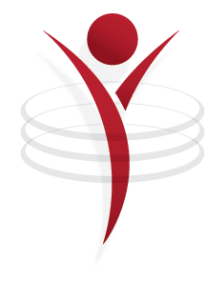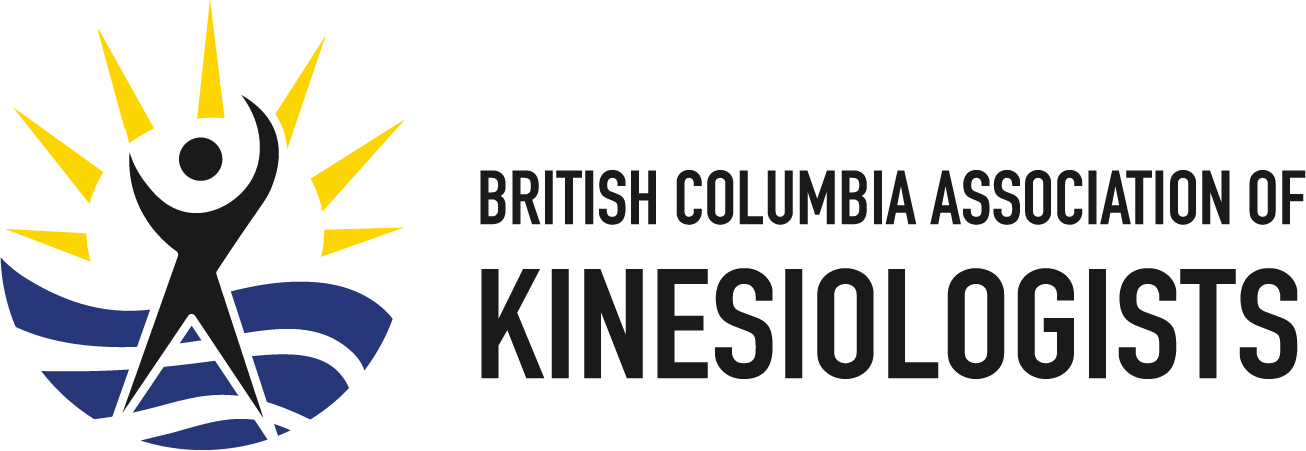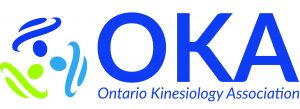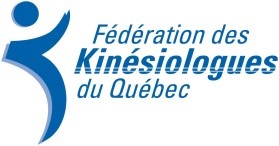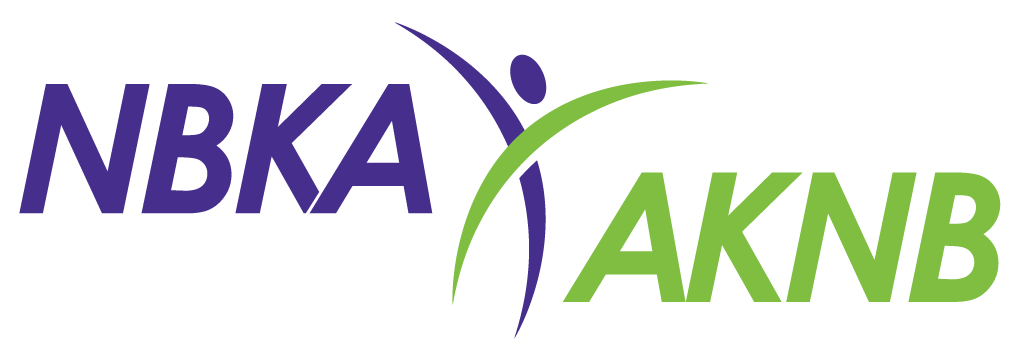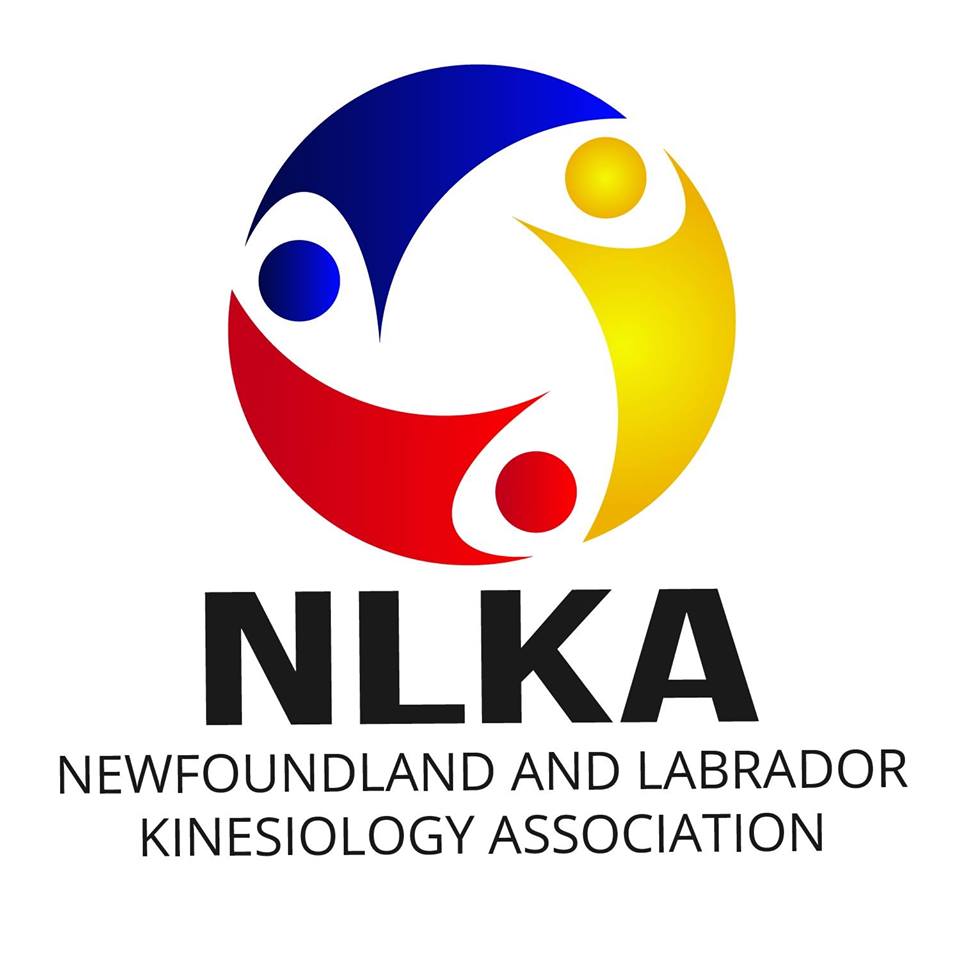Field, Industries and Services offered by Kins
Throughout you university degree, you have probably already identified areas of kinesiology that interest you. You have probably already acquired experience in some fields via for example internships or a student job. Nous that you have completed your bachelor's degree, that you are a member in good standing of your provincial association or CKA, it is now time to go looking for a job.
In Canada, the title of Kinesiologist is not a protected title for the purposes of the law in all Canadian provinces except Ontario. In Ontario, the profession is regulated by legislation requiring an exclusive title of Registered Kinesiologist.
In the other provinces, we find many other titles such as certified, practicing, professional, accredited or affiliated kinesiologist. All these titles are accepted by the Provincial Kinesiology Associations, and the CKA, and are granted when one meets all the requirements to practice. When recognized by PKAs and the CKA, one benefits from membership advantages such as the privilege of issuing receipts to customers so that they can claim reimbursement from insurance companies. Insurance companies verify the status of Kinesiologists with their PKAs and the CKA, before authorizing the refund.
Currently in Canada, kinesiologists can hold a variety of job titles. The CKA is working to reduce the number of titles in order to prevent confusion among the public, health professionals and insurance companies. The variety of titles is a result of differences in provincial laws. PKAs, and the CKA, prefer the use of a single title: kinesiologist.
Here are some examples of job titles:
- Kinesiologist
- Kinesiologist registered, affiliated or accredited
- Clinical Kinesiologist
- Kinesiologist / teacher
- Kinesiologist / physical trainer
- Kinesiologist / Health Promotion, Community Health
- Certified Personal Trainer
- Exercise Physiologist (certified/clinical)
- Exercise Specialist
- Manual therapist (not recognized by some provincial associations)
- Exercise Specialist in Cardiac Rehabilitation
- Ergonomist or ergonomic designer in the workplace (may be a specialty in some provinces)
- Fitness Instructor
- Researcher in the science of physical activity
A Kinesiologist may have an area of special interest to them, and works with a variety of clients and in a variety of environments, see the following diagram:
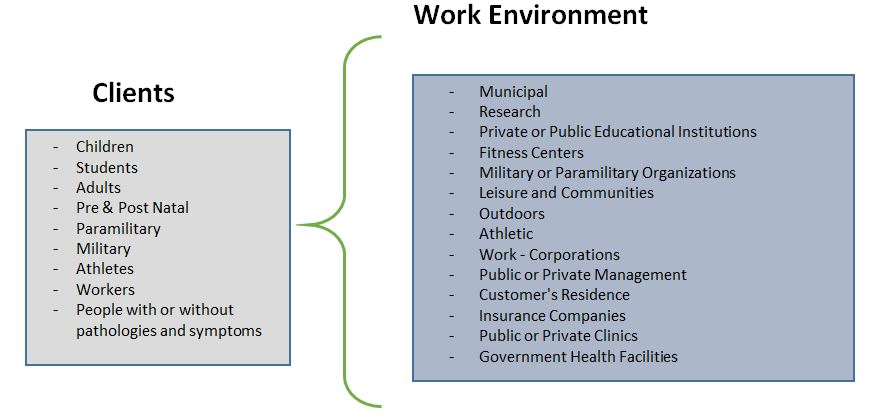
In the above diagram, for each of these environments, Kinesiologists can offer a wide variety of services within their scope of practice. For example :
- In a health facility, you will find Kinesiologists providing rehabilitation services for: cardiac conditions, neurological disease, spinal cord injury, hemodialysis, encephalopathies (stroke, CBT, concussion, tumor), oncology, metabolic diseases, pulmonary diseases, mental health, etc.
- In the workplace, you will find them performing pre-hiring tests, ergonomics (specialization in some provinces), return to work programs, wellness programs, etc.
Kinesiology is the study of the dynamics[1] of human movement, including all the components involved (anatomical, physiological, neurological, biochemical, biomechanical, neuromotor, psychological), as we interact with our environment. Kinesiology is also defined as human kinetics or the scientific study of how we move. The term is derived from the Greek kinesis, to move.
Kinesiology includes the following fields of study:
- Physiology
- Biomechanics
- Neurology
- Mobility
- Anatomy
- Psychology
- Sociology
- Posturology
- Anthropometry
In Canada, these different fields are grouped together under the kinesiology umbrella, focusing on all aspects of human locomotion.
Kinesiologists work with people of all ages and physical abilities, and in many settings to help them achieve their health and wellness goals. Kinesiologists work with:
- Students
- Adults
- Seniors and the elderly
- Pre- and post-natal clients
- Military personnel
- Athletes
- Children
- Employees
- Anyone with or without pathologies and symptoms
Kinesiologists help improve quality of life, often using interventions that include physical activity.
Kinesiology interventions are varied and target all Canadians, regardless of age and whether they are affected by health problems or not. Kinesiologists work in:
- Municipalities
- Research organizations
- Private or public educational institutions
- Fitness centres
- Military or public security organizations
- Community groups
- Outdoor organizations
- Athletic organizations
- Public and private employees
- At-home interventions
- Public or privately managed centres
- Public or private rehabilitation clinics
- Government health facilities
- Insurance companies
TARGET CLIENTELE
ASYMPTOMATIC (WITHOUT SYMPTOMS OR PATHOLOGY):
- Adults in general, including pregnant women
- Specific clienteles (including paramilitary and military services, employees, astronauts)
- Athletes and adventurers
- Children and adolescents
- Students (teaching, and scholarship athletes)
- Seniors and aging populations
SYMPTOMATIC AND WITH CLINICAL CONDITIONS:
- Metabolic conditions
- Cardiovascular conditions
- Pulmonary conditions
- Neurological conditions
- Musculoskeletal problems
- Mental health and psychiatric diagnoses
- Other conditions (including chronic pain and sensory disorders)
The health, and physical activity needs of any client include many factors. For this reason, an interdisciplinary and collaborative approach generally ensures a superior level of service. Kinesiologists often collaborate with other health professionals on multidisciplinary and interdisciplinary interventions, prevention, treatment, and to improve sport performance. They also support medical teams in evaluations and are involved in developing treatment and intervention plans.
Kinesiologists complement other healthcare professionals with the wide range of their knowledge and broad scope of their practice. Here are some examples of what kinesiologists can bring to the team:
- Provide prevention, promotion, treatment, and rehabilitation services to various health facilities, including mental health clinics and private clinics
- Neuromusculoskeletal and functional evaluations
- Ergonomics in workplace and occupational health cases
- High-performance coaching and fitness training
- Promoting public health
- Clinical management and coordination
- Case management for insurance companies
- Personal training and physical condition coaching
- Researching
- Lecturing, instructing, and teaching
- Promoting physical activity and adopting healthy and physically active lifestyles
Kinesiology is an evolving profession, continually adapting to changing client needs
COMPLEMENTARY TRAINING AND SPECIALIZATIONS
The initial bachelor’s degree in kinesiology can be the basis for additional training, specialization, or a different professional practice. All training or specialization must meet the standards of the province you wish to practice in. Treatment methods are not regulated the same way in all provinces. The CKA recommends that you check with your provincial kinesiology association to see what services you can legally provide before you make any decisions:
- In some provinces, additional training in kinesiology can lead to other services like occupational therapy. In other provinces, occupational therapy is a regulated profession and requires specific and exclusive training. In those provinces, you cannot legally provide occupational therapy or ergo-therapy without being a member of the college or order.
- Provincial kinesiology associations have the right to restrict the scope of the practice in their province. In some provinces, for example, kinesiologists also have to be registered osteopaths if they wish to practice osteopathy. In some provinces, the same applies to kinesiologists wishing to use manual therapy techniques.
WORKING WITH OTHER HEALTHCARE PROVIDERS
Kinesiologists respect the expertise of their health partners. In areas beyond our scope of practice, we always refer clients to the appropriate, accredited, healthcare professionals. Kinesiologists are able to provide basic advice on different related subjects (like nutrition) based on their initial level of education. However, education and acquired competency in their own field of practice are not sufficient to incorporate all the nuances required to target specific needs. It can happen that the conveyed information, though exact and provided in good faith, can be unsuitable for a particular client. Which is why we prioritize interdisciplinary and multidisciplinary work and refer clients to the appropriate healthcare expert whenever necessary.
[1] Dynamic theory adopts a more radical point of view, assuming that the behaviour of a complex system emerges from a network of constraints, related either to the task, the organism, or the environment (Newell, 1986). Adapted by the CKA from La théorie dynamique adopte un point de vue plus radical, postulant que le comportement d’un système complexe émerge d'un réseau de contraintes, liées soit à la tâche, soit à l’organisme, soit à l’environnement (Newell, 1986).

